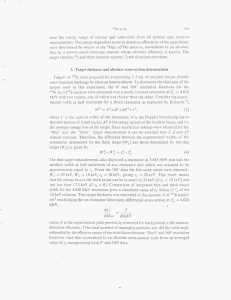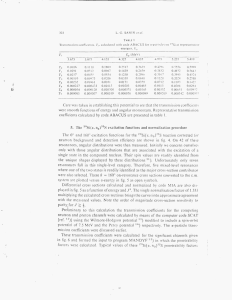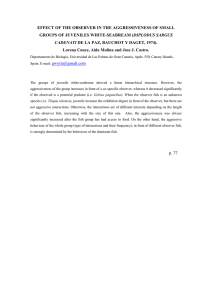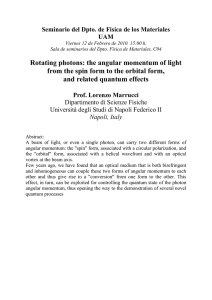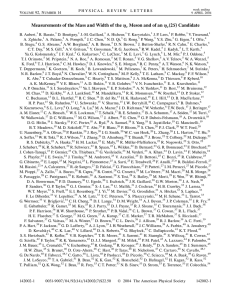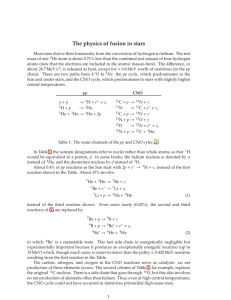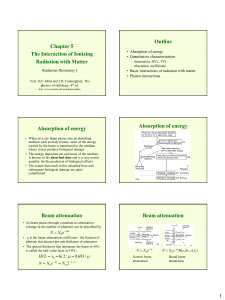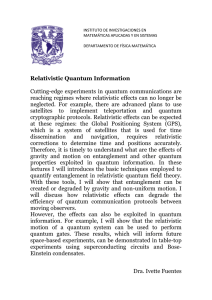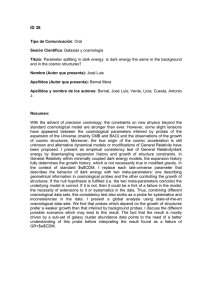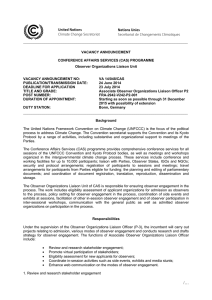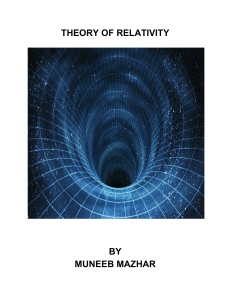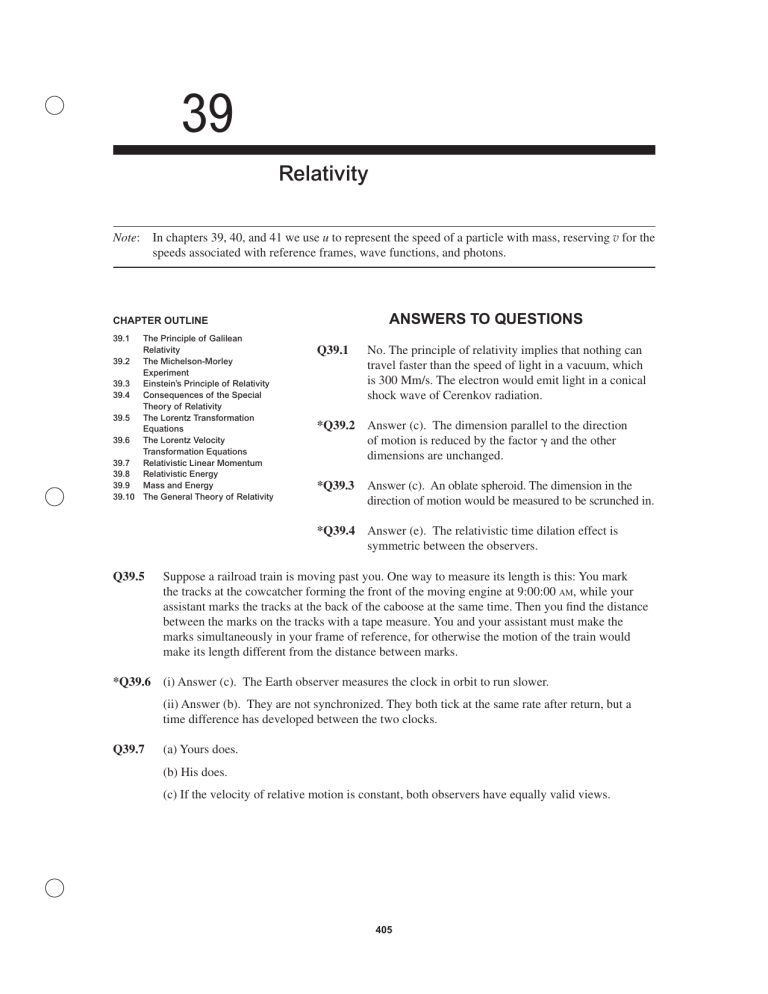
39 Relativity Note: In chapters 39, 40, and 41 we use u to represent the speed of a particle with mass, reserving v for the speeds associated with reference frames, wave functions, and photons. ANSWERS TO QUESTIONS CHAPTER OUTLINE 39.1 The Principle of Galilean Relativity 39.2 The Michelson-Morley Experiment 39.3 Einstein’s Principle of Relativity 39.4 Consequences of the Special Theory of Relativity 39.5 The Lorentz Transformation Equations 39.6 The Lorentz Velocity Transformation Equations 39.7 Relativistic Linear Momentum 39.8 Relativistic Energy 39.9 Mass and Energy 39.10 The General Theory of Relativity Q39.1 No. The principle of relativity implies that nothing can travel faster than the speed of light in a vacuum, which is 300 Mm/s. The electron would emit light in a conical shock wave of Cerenkov radiation. *Q39.2 Answer (c). The dimension parallel to the direction of motion is reduced by the factor ␥ and the other dimensions are unchanged. *Q39.3 Answer (c). An oblate spheroid. The dimension in the direction of motion would be measured to be scrunched in. *Q39.4 Answer (e). The relativistic time dilation effect is symmetric between the observers. Q39.5 Suppose a railroad train is moving past you. One way to measure its length is this: You mark the tracks at the cowcatcher forming the front of the moving engine at 9:00:00 AM, while your assistant marks the tracks at the back of the caboose at the same time. Then you find the distance between the marks on the tracks with a tape measure. You and your assistant must make the marks simultaneously in your frame of reference, for otherwise the motion of the train would make its length different from the distance between marks. *Q39.6 (i) Answer (c). The Earth observer measures the clock in orbit to run slower. (ii) Answer (b). They are not synchronized. They both tick at the same rate after return, but a time difference has developed between the two clocks. Q39.7 (a) Yours does. (b) His does. (c) If the velocity of relative motion is constant, both observers have equally valid views. 405 406 Chapter 39 Q39.8 Get a Mr. Tompkins book by George Gamow for a wonderful fictional exploration of this question. Driving home in a hurry, you push on the gas pedal not to increase your speed by very much, but rather to make the blocks get shorter. Big Doppler shifts in wave frequencies make red lights look green as you approach them and make car horns and car radios useless. High-speed transportation is very expensive, requiring huge fuel purchases. And it is dangerous, as a speeding car can knock down a building. Having had breakfast at home, you return hungry for lunch, but you find you have missed dinner. There is a five-day delay in transmission when you watch the Olympics in Australia on live television. It takes ninety-five years for sunlight to reach Earth. We cannot see the Milky Way; the fireball of the Big Bang surrounds us at the distance of Rigel or Deneb. Q39.9 By a curved line. This can be seen in the middle of Speedo’s world-line in Figure 39.11, where he turns around and begins his trip home. Q39.10 A microwave pulse is reflected from a moving object. The waves that are reflected back are Doppler shifted in frequency according to the speed of the target. The receiver in the radar gun detects the reflected wave and compares its frequency to that of the emitted pulse. Using the frequency shift, the speed can be calculated to high precision. Be forewarned: this technique works if you are either traveling toward or away from your local law enforcement agent! Q39.11 This system would be seen as a star moving in an elliptical path. Just like the light from a star in a binary star system, the spectrum of light from the star would undergo a series of Doppler shifts depending on the star’s speed and direction of motion relative to the observer. The repetition rate of the Doppler shift pattern is the period of the orbit. Information about the orbit size can be calculated from the size of the Doppler shifts. Q39.12 According to p = γ mu , doubling the speed u will make the momentum of an object increase by 12 ⎡ c2 − u 2 ⎤ the factor 2 ⎢ 2 . 2 ⎥ ⎣ c − 4u ⎦ *Q39.13 From E2 ⫽ p2c2 ⫹ m2c4 ⫽ (mc2 ⫹ K )2 we consider pc = 2 Kmc 2 + K 2 . For a photon, pc ⫽ E. For particles with mass, the greater the mass the greater the momentum if K is always 1 MeV. The ranking is d > b > c > a. Q39.14 As the object approaches the speed of light, its kinetic energy grows without limit. It would take an infinite investment of work to accelerate the object to the speed of light. *Q39.15 (i) Answer (a). (ii) (c) and (iii) (d). There is no upper limit on the momentum or energy of an electron. As more energy E is fed into the object without limit, its speed approaches the speed of light and its momentum approaches E . c *Q39.16 Answer (b). Quasar light moves at three hundred million meters per second, just like the light from a firefly at rest. Q39.17 Any physical theory must agree with experimental measurements within some domain. Newtonian mechanics agrees with experiment for objects moving slowly compared to the speed of light. Relativistic mechanics agrees with experiment for objects at all speeds. Thus the two theories must and do agree with each other for ordinary nonrelativistic objects. Both statements given in the question are formally correct, but the first is clumsily phrased. It seems to suggest that relativistic mechanics applies only to fast-moving objects. Relativity 407 Q39.18 The point of intersection moves to the right. To state the problem precisely, let us assume that each of the two cards moves toward the other parallel to the long dimension of the picture, with 2u velocity of magnitude u. The point of intersection moves to the right at speed = 2u cot φ , tan φ where f is the small angle between the cards. As f approaches zero, cot φ approaches infinity. Thus the point of intersection can move with a speed faster than c if v is sufficiently large and f sufficiently small. For example, take u = 500 m s and φ = 0.000 19° . If you are worried about holding the cards steady enough to be sure of the angle, cut the edge of one card along a curve so that the angle will necessarily be sufficiently small at some place along the edge. Let us assume the spinning flashlight is at the center of a grain elevator, forming a circular screen of radius R. The linear speed of the spot on the screen is given by v = ω R, where w is the angular speed of rotation of the flashlight. With sufficiently large w and R, the speed of the spot moving on the screen can exceed c. Neither of these examples violates the principle of relativity. Both cases are describing a point of intersection: in the first case, the intersection of two cards and in the second case, the intersection of a light beam with a screen. A point of intersection is not made of matter so it has no mass, and hence no energy. A bug momentarily at the intersection point could yelp, take a bite out of one card, or reflect the light. None of these actions would result in communication reaching another bug so soon as the intersection point reaches him. The second bug would have to wait for sound or light to travel across the distance between the first bug and himself, to get the message. As a child, the author used an Erector set to build a superluminal speed generator using the intersecting-cards method. Can you get a visible dot to run across a computer screen faster than light? Want’a see it again? Q39.19 Special relativity describes inertial reference frames: that is, reference frames that are not accelerating. General relativity describes all reference frames. Q39.20 The downstairs clock runs more slowly because it is closer to the Earth and hence in a stronger gravitational field than the upstairs clock. SOLUTIONS TO PROBLEMS Section 39.1 P39.1 The Principle of Galilean Relativity The first observer watches some object accelerate under applied forces. Call the instantaneous velocity of the object v1 . The second observer has constant velocity v 21 relative to the first, and measures the object to have velocity v 2 = v1 − v 21. dv dv The second observer measures an acceleration of a2 = 2 = 1 . dt dt This is the same as that measured by the first observer. In this nonrelativistic case, they measure the same forces as well. Thus, the second observer also confirms that ΣF = ma . P39.2 The laboratory observer notes Newton’s second law to hold: F1 = ma1 (where the subscript 1 denotes the measurement was made in the laboratory frame of reference). The observer in the accelerating frame measures the acceleration of the mass as a 2 = a1 − a ′ (where the subscript 2 implies the measurement was made in the accelerating frame of reference, and the primed acceleration term is the acceleration of the accelerated frame with respect to the laboratory frame of reference). If Newton’s second law held accelerating frame, that for the observer would then find valid the relation F2 = ma 2 or F1 = ma 2 (since F1 = F2 and the mass is unchanged in each). But, instead, the accelerating frame observer will find that F2 = ma 2 − ma ′, which is not Newton’s second law. 408 P39.3 Chapter 39 In the rest frame, pi = m1 v1i + m2 v2i = ( 2 000 kg ) ( 20.0 m s ) + (1 500 kg ) ( 0 m s ) = 4.00 × 10 4 kg ⋅ m s p f = ( m1 + m2 ) v f = ( 2 000 kg + 1 500 kg ) v f Since pi = p f , vf = 4.00 × 10 4 kg ⋅ m s = 11.429 m s 2 000 kg + 1 500 kg In the moving frame, these velocities are all reduced by +10.0 m/s. v1′i = v1i − v ′ = 20.0 m s − ( +10.0 m s ) = 10.0 m s v2′i = v2i − v ′ = 0 m s − ( +10.0 m s ) = −10.0 m s v ′f = 11.429 m s − ( +10.0 m s ) = 1.429 m s Our initial momentum is then pi′ = m1 v1′i + m2 v2′i = ( 2 000 kg ) (10.0 m s ) + (1 500 kg ) ( −10.0 m s ) = 5 000 kg ⋅ m s and our final momentum has the same value: p ′f = ( 2 000 kg + 1 500 kg ) v ′f = ( 3 500 kg ) (1.429 m s ) = 5 000 kg ⋅ m s Section 39.2 The Michelson-Morley Experiment Section 39.3 Einstein’s Principle of Relativity Section 39.4 Consequences of the Special Theory of Relativity P39.4 L = Lp ⎛ L⎞ v = c 1− ⎜ ⎟ ⎝ Lp ⎠ v2 1− 2 c 2 2 ⎛ Lp 2⎞ 1 = c 1 − = 0.866c Taking L = where L p = 1.00 m gives v = c 1 − ⎜ ⎟ 2 4 ⎝ Lp ⎠ Lp P39.5 P39.6 ∆t = 12 ∆t p so ⎡1 − ( v c )2 ⎤ ⎣ ⎦ 12 For ∆t = 2 ∆t p (a) γ = ⎡ ⎛ ∆t p ⎞ 2 ⎤ v = c ⎢1 − ⎜ ⎟ ⎥ ⎢⎣ ⎝ ∆t ⎠ ⎥⎦ 12 ⎡ ⎛ ∆t ⎞ 2 ⎤ p v = c ⎢1 − ⎜ ⎟ ⎥ ∆ 2 t ⎢⎣ ⎝ p⎠ ⎥ ⎦ 1 1 − ( v c) 2 = 1 1 − ( 0.500 ) 2 = 12 1 = c ⎡⎢1 − ⎤⎥ ⎣ 4⎦ = 0.866c 2 3 The time interval between pulses as measured by the Earth observer is ∆t = γ∆t p = 2 ⎛ 60.0 s ⎞ = 0.924 s 3 ⎝ 75.0 ⎠ Thus, the Earth observer records a pulse rate of (b) 60.0 s min = 64.9 min . 0.924 s At a relative speed v = 0.990 c, the relativistic factor g increases to 7.09 and the pulse rate recorded by the Earth observer decreases to 10.6 min . That is, the life span of the astronaut (reckoned by the duration of the total number of his heartbeats) is much longer as measured by an Earth clock than by a clock aboard the space vehicle. Relativity P39.7 ∆t p ∆t = γ∆t p = 1 − v2 c2 ⎛ ⎛ v2 ⎞ v2 ⎞ ∆t p = ⎜ 1 − 2 ⎟ ∆t ≅ ⎜ 1 − 2 ⎟ ∆t ⎝ c ⎠ 2c ⎠ ⎝ so ⎛ v2 ⎞ ∆t − ∆t p = ⎜ 2 ⎟ ∆t ⎝ 2c ⎠ 1.00 × 10 6 m v = 1 000 km h = = 277.8 m s 3 600 s v = 9.26 × 10 −7 c and If then ( ∆t − ∆t ) = ( 4.28 × 10 ) (3 600 s) = 1.54 × 10 −13 and P39.8 For (a) p v = 0.990 , γ = 7.09 c The muon’s lifetime as measured in the Earth’s rest frame is ∆t = 4.60 km 0.990c and the lifetime measured in the muon’s rest frame is ∆t p = (b) P39.9 409 ⎤ 1 ⎡ 4.60 × 10 3 m ∆t = ⎢ ⎥ = 2.18 µs 8 γ 7.09 ⎢⎣ 0.990 ( 3.00 × 10 m s ) ⎥⎦ 2 L p 4.60 × 10 3 m v L = Lp 1 − ⎛ ⎞ = = = 649 m ⎝ c⎠ γ 7.09 The spaceship is measured by the Earth observer to be length-contracted to L = Lp 1 − v2 c2 or ⎛ v2 ⎞ L2 = L2p ⎜ 1 − 2 ⎟ ⎝ c ⎠ Also, the contracted length is related to the time required to pass overhead by: v2 ( ct )2 c2 2 v2 2 v Equating these two expressions gives L2p − L2p 2 = ( ct ) 2 c c 2 v ⎡⎣ L2p + ( ct )2 ⎤⎦ 2 = L2p or c L = vt or L2 = v 2 t 2 = Using the given values: L p = 300 m this becomes (1.41 × 10 giving v = 0.800 c 5 and m2 ) t = 7.50 × 10 −7 s v2 = 9.00 × 10 4 m 2 c2 −9 s = 1.54 ns 410 P39.10 Chapter 39 (a) The spaceship is measured by Earth observers to be of length L, where L = Lp 1 − v2 c2 v∆t = L p 1 − v2 c2 and L = v∆t and ⎛ v2 ⎞ v 2 ∆t 2 = L2p ⎜ 1 − 2 ⎟ ⎝ c ⎠ ⎛ L2p ⎞ Solving for v, v 2 ⎜ ∆t 2 + 2 ⎟ = L2p c ⎠ ⎝ v= cL p c ∆t 2 + L2p 2 (b) The tanks move nonrelativistically, so we have v = (c) For the data in problem 9, c ( 300 m ) v= (3 × 10 8 m s ) ( 0.75 × 10 2 −6 s ) + ( 300 m ) 2 2 = 300 m = 4.00 m s . 75 s c ( 300 m ) 2252 + 300 2 m = 0.800 c in agreement with problem 9. For the data in part (b), c ( 300 m ) c ( 300 m ) v= = 2 (3 × 108 m s ) ( 75 s )2 + (300 m )2 ( 2.25 × 1010 )2 + 300 2 m = 1.33 × 10 −8 c = 4.00 m s in agreement with part (b). P39.11 We find Cooper’s speed: GMm m v 2 = r2 r Solving, ⎡ GM ⎤ v=⎢ ⎥ ⎣ ( R + h) ⎦ 12 Then the time period of one orbit is (a) T= ⎡ ( 6.67 × 10 −11 ) ( 5.98 × 10 24 ) ⎤ =⎢ 6 6 ⎥ ⎢⎣ ( 6.337 × 10 + 0.160 × 10 ) ⎥⎦ 12 = 7.82 km s 6 2π ( R + h ) 2π ( 6.53 × 10 ) = = 5.25 × 10 3 s v 7.82 × 10 3 ⎡⎛ v2 ⎞ The time difference for 22 orbits is ∆t − ∆t p = (γ − 1) ∆t p = ⎢⎜ 1 − 2 ⎟ c ⎠ ⎢⎣⎝ −1 2 ⎤ − 1⎥ ( 22T ) ⎥⎦ 2 ⎛ 1 v2 1 ⎛ 7.82 × 10 3 m s ⎞ ⎞ ) ∆t − ∆t p ≈ ⎜ 1 + − 1 22 T = 22 ( 5.25 × 10 3 s ) = 39.2 µs ( ⎟⎠ ⎝ 2 c2 2 ⎜⎝ 3 × 108 m s ⎟⎠ (b) For each one orbit Cooper aged less by ∆t − ∆t p = accurate to one digit . P39.12 γ = 1 1 − ( v2 c2 ) = 1.01 so v = 0.140 c 39.2 µs = 1.78 µs. The press report is 22 Relativity P39.13 (a) Since your ship is identical to his, and you are at rest with respect to your own ship, its length is 20.0 m . P39.14 (b) His ship is in motion relative to you, so you measure its length contracted to 19.0 m . (c) We have L = Lp 1 − from which L 19.0 m v2 = = 0.950 = 1 − 2 and v = 0.312c L p 20.0 m c v2 c2 In the Earth frame, Speedo’s trip lasts for a time ∆t = 20.0 ly ∆x = = 21.05 yr v 0.950 ly yr Speedo’s age advances only by the proper time interval ∆t p = ∆t = 21.05 yr 1 − 0.952 = 6.574 yr during his trip γ Similarly for Goslo, ∆t p = v2 20.0 ly ∆x 1− 2 = 1 − 0.752 = 17.64 yr v 0.750 ly yr c While Speedo has landed on Planet X and is waiting for his brother, he ages by 20.0 ly 20.0 ly − = 5.614 yr 0.750 ly yr 0.950 ly yr Then Goslo ends up older by 17.64 yr − ( 6.574 yr + 5.614 yr ) = 5.45 yr . P39.15 The orbital speed of the Earth is as described by ΣF = ma: v= GmS = r (6.67 × 10 −11 N ⋅ m 2 kg2 ) (1.99 × 10 30 kg ) 1.496 × 1011 m GmS mE mE v 2 = r2 r = 2.98 × 10 4 m s The maximum frequency received by the extraterrestrials is fobs = fsource 1 + ( 2.98 × 10 4 m s ) ( 3.00 × 108 m s ) 1+ v c = ( 57.0 × 10 6 Hz ) 1− v c 1 − ( 2.98 × 10 4 m s ) ( 3.00 × 108 m s ) = 57.005 66 × 10 6 Hz The minimum frequency received is fobs = fsource 1 − ( 2.98 × 10 4 m s ) ( 3.00 × 108 m s ) 1− v c = ( 57.0 × 10 6 Hz ) 1+ v c 1 + ( 2.98 × 10 4 m s ) ( 3.00 × 108 m s ) = 56.994 34 × 10 6 Hz The difference, which lets them figure out the speed of our planet, is ( 57.005 66 − 56.994 34 ) × 106 Hz = 1.13 × 10 4 Hz 411 412 P39.16 Chapter 39 (a) Let fc be the frequency as seen by the car. Thus, fc = fsource and, if f is the frequency of the reflected wave, f = fc (b) (c) (c + v) (c − v) Using the above result, f ( c − v ) = fsource ( c + v ) which gives ( f − fsource ) c = ( f + fsource ) v ≈ 2 fsource v The beat frequency is then fbeat = f − fsource = fbeat = λ= P39.17 c+v c−v f = fsource Combining gives c+v c−v ( 2 ) ( 30.0 m s ) (10.0 × 10 9 Hz ) 3.00 × 10 m s 8 c = fsource fbeat λ 2 = ( 2 ) ( 30.0 m s ) ( 0.030 0 m ) 2 fsource v 2v = λ c = 2 000 Hz = 2.00 kHz 3.00 × 108 m s = 3.00 cm 10.0 × 10 9 Hz ∆v = ∆fbeat λ ( 5 Hz ) ( 0.030 0 m ) = = 0.075 0 m s ≈ 0.2 mi h 2 2 (d) v= (a) When the source moves away from an observer, the observed frequency is so ⎛ c − vs ⎞ fobs = fsource ⎜ ⎝ c + vs ⎟⎠ 12 where vs = vsource When vs << c, the binomial expansion gives ⎛ c − vs ⎞ ⎜⎝ c + v ⎟⎠ s 12 12 v ⎤ ⎡ = ⎢1 − ⎛ s ⎞ ⎥ ⎣ ⎝ c ⎠⎦ ⎡ ⎛ vs ⎞ ⎤ ⎢⎣1 + ⎝ c ⎠ ⎥⎦ −1 2 v v v ≈ ⎛1 − s ⎞ ⎛1 − s ⎞ ≈ ⎛1 − s ⎞ ⎝ 2c ⎠ ⎝ 2c ⎠ ⎝ c⎠ v fobs ≈ fsource ⎛ 1 − s ⎞ ⎝ c⎠ So, The observed wavelength is found from c = λobs fobs = λ fsource : λobs = λ fsource λ fsource λ ≈ = fobs fsource (1 − vs c ) 1 − vs c ⎛ v c ⎞ ⎛ 1 ⎞ ∆λ = λobs − λ = λ ⎜ −1 = λ ⎜ s ⎝ 1 − vs c ⎟⎠ ⎝ 1 − vs c ⎟⎠ Since 1 − (b) vs ≈ 1, c ∆λ vsource ≈ λ c 20.0 nm ⎞ ⎛ ∆λ ⎞ vsource = c ⎜ = c⎛ = 0.050 4 c ⎝ 397 nm ⎠ ⎝ λ ⎟⎠ Relativity P39.18 413 For the light as observed c 1+ v c 1+ v c c fobs = = fsource = 1− v c 1 − v c λsource λobs 1 + v c λsource 650 nm = = 1− v c 520 nm λobs 1+ 1+ v c = 1.252 = 1.562 1− v c v v = 1.562 − 1.562 c c v 0.562 = = 0.220 c 2.562 v = 0.220 c = 6.59 × 10 7 m s Section 39.5 P39.19 The Lorentz Transformation Equations Let Suzanne be fixed in reference from S and see the two light-emission events with coordinates x1 = 0, t1 = 0, x2 = 0, t 2 = 3 µs. Let Mark be fixed in reference frame S′ and give the events coordinate x1′ = 0 , t1′ = 0 , t 2′ = 9 µs. (a) Then we have v ⎛ t2′ = γ t2 − 2 x 2 ⎞ ⎝ ⎠ c 1 9 µs = 1 − v2 c ( 3 µs − 0 ) 2 v2 8 = c2 9 (b) P39.20 γ = 1− v2 1 = c2 3 v = 0.943c ⎛ 3 × 108 m s ⎞ 3 x2′ = γ ( x2 − vt 2 ) = 3 ( 0 − 0.943c × 3 × 10 −6 s ) ⎜ ⎟⎠ = 2.55 × 10 m ⎝ c 1 1− v c 2 2 = 1 1 − 0.9952 = 10.0 We are also given: L1 = 2.00 m, and θ = 30.0° (both measured in a reference frame moving relative to the rod). Thus, L1x = L1 cos θ1 = ( 2.00 m ) ( 0.867 ) = 1.73 m and L1y = L1 sin θ1 = ( 2.00 m ) ( 0.500 ) = 1.00 m L2 x γ FIG. P39.20 L2 x is a proper length, related to L1x by L1x = Therefore, L2 x = 10.0 L1x = 17.3 m and L2 y = L1y = 1.00 m (Lengths perpendicular to the motion are unchanged.) ( L2 x ) 2 + ( L2 y ) (a) L2 = (b) θ 2 = tan −1 L2 y L2 x 2 gives L2 = 17.4 m gives θ 2 = 3.30° 414 P39.21 Chapter 39 Einstein’s reasoning about lightning striking the ends of a train shows that the moving observer sees the event toward which she is moving, event B, as occurring first. The S-frame coordinates of the events we may take as ( x = 0, y = 0, z = 0, t = 0) and ( x = 100 m, y = 0, z = 0, t = 0). Then the coordinates in S ′ are given by the Lorentz transformation. Event A is at ( x ′ = 0 , y ′ = 0, z ′ = 0, t ′ = 0). The time of event B is v 1 80 m ⎞ ⎛ 0 − 0.8c (100 m )⎞ = 1.667 ⎛ − −7 t ′ = γ ⎛ t − 2 x⎞ = 2 ⎜⎝ 3 × 108 m s ⎟⎠ = −4.44 × 10 s 2 ⎝ ⎝ ⎠ c ⎠ c 1 − 0.8 The time elapsing before A occurs is 444 ns . P39.22 (a) From the Lorentz transformation, the separations between the blue-light and red-light events are described by 0 = γ ⎡⎣ 2.00 m − v (8.00 × 10 −9 s ) ⎤⎦ ∆x ′ = γ ( ∆x − v∆t ) v= (b) 2.00 m = 2.50 × 108 m s 8.00 × 10 −9 s γ = 1 1 − ( 2.50 × 10 m s ) 8 2 (3.00 × 10 8 m s) 2 = 1.81 Again from the Lorentz transformation, x ′ = γ ( x − vt ): x ′ = 1.81 ⎡⎣3.00 m − ( 2.50 × 108 m s ) (1.00 × 10 −9 s ) ⎦⎤ x ′ = 4.97 m (c) v t ′ = γ ⎛ t − 2 x⎞ : ⎝ c ⎠ ⎡ ( 2.50 × 108 m s ) (3.00 m )⎤⎥ t ′ = 1.81 ⎢1.00 × 10 −9 s − ⎢⎣ ⎥⎦ (3.00 × 108 m s )2 t ′ = −1.33 × 10 −8 s Section 39.6 P39.23 u x′ = The Lorentz Velocity Transformation Equations ux − v −0.750 c − 0.750 c = −0.960 c = 1 − u x v c 2 1 − ( −0.750 ) ( 0.750 ) speed = 0.960 c FIG. P39.23 P39.24 u x = Enterprise velocity v = Klingon velocity From Equation 39.16 u x′ = 0.900 c − 0.800 c ux − v = = 0.357c 2 1 − ux v c 1 − ( 0.900 ) ( 0.800 ) FIG. P39.24 Relativity Section 39.7 P39.25 (a) Relativistic Linear Momentum p = γ mu ; for an electron moving at 0.010 0c, γ = 1 1 − (u c ) 2 = 1 1 − ( 0.010 0 ) 2 = 1.000 05 ≈ 1.00 p = 1.00 ( 9.11 × 10 −31 kg ) ( 0.010 0 ) ( 3.00 × 108 m s ) Thus, p = 2.73 × 10 −24 kg ⋅ m s (b) (c) P39.26 Following the same steps as used in part (a), we find at 0.500c, γ = 1.15 and p = 1.58 × 10 −22 kg ⋅ m s At 0.900c, γ = 2.29 and p = 5.64 × 10 −22 kg ⋅ m s = γ mu p= we find the difference ∆ from the classical momentum, mu: ∆p = γ mu − mu = (γ − 1) mu The difference is 1.00% when (γ − 1) mu = 0.010 0γ mu : γ = 2 (b) 1 − (u c ) u = 0.141c The difference is 10.0% when (γ − 1) mu = 0.100γ mu : γ = 2 p − mu γ mu − mu = = γ − 1: mu mu 2 1 1 = 2 0.990 1 − (u c ) u 2 thus 1 − ⎛ ⎞ = ( 0.990 ) , and ⎝ c⎠ u 2 thus 1 − ⎛ ⎞ = ( 0.900 ) and ⎝ c⎠ P39.27 mu Using the relativistic form, (a) 415 1 1 = 2 0.900 1 − (u c ) u = 0.436c γ −1 = 2 1 1 − (u c ) 2 1 u 1 u −1 ≈ 1+ ⎛ ⎞ −1 = ⎛ ⎞ 2 ⎝ c⎠ 2 ⎝ c⎠ 2 p − mu 1 ⎛ 90.0 m s ⎞ = ⎜ = 4.50 × 10 −14 mu 2 ⎝ 3.00 × 108 m s ⎟⎠ 2 416 Chapter 39 *P39.28 We can express the proportionality of the speeding fine to the excess momentum as F = d ( p − p ) where F is the fine, d is a proportionality constant, p is the magnitude of the vehicle’s momentum, and p is the magnitude of its momentum as it travels at 90 km/h. (a) METHOD ONE. For low speeds, the classical expression for momentum is accurate. Our equation describes the two cases $80 = d ⎡⎣ m (190 km h ) − m ( 90 km h ) ⎤⎦ and Fa = d ⎡⎣ m (1 090 km h ) − m ( 90 km h ) ⎤⎦ Dividing gives m (1 000 km h ) Fa ⇒ Fa = $800 . = m (100 km h ) $80 METHOD TWO. The relativistic momentum expression is always accurate: ⎛ ⎞ m (190 km h ) m ( 90 km h ) $80 = d ⎜ − ⎟ 2 ⎜⎝ 1 − (190 km h )2 c 2 1 − ( 90 km h ) c 2 ⎟⎠ ⎛ ⎞ m (1 090 km h ) m (190 km h ) Fa = d ⎜ − ⎟ 2 ⎜⎝ 1 − (1 090 km h )2 c 2 1 − (190 km h ) c 2 ⎟⎠ To three or even to six digits, the answer is the same: Fa = $80 (10 ) = $800 . (b) Now the high-speed case must be described relativistically. The speed of light is 3 × 108 m s = 1.08 × 10 9 km h . $80 = dm (100 km h ) ⎛ ⎞ m (1.000 000 09 × 10 9 km h ) ⎟ Fb = d ⎜ 90 m km h − ( ) ⎜ 1 − (1.000 000 09 × 10 9 1.08 × 10 9 )2 ⎟ ⎝ ⎠ Fb = dm ( 2.65 × 10 9 km h ) again dividing, Fb 2.65 ×109 = ⇒ Fb = $2.12 ×109 . 2 $80 10 Relativity P39.29 Relativistic momentum of the system of fragments must be conserved. For total momentum to be zero after as it was before, we must have, with subscript 2 referring to the heavier fragment, and subscript 1 to the lighter, p2 = p1 or γ 2 m2 u2 = γ 1 m1u1 = or (1.67 × 10 −27 2.50 × 10 −28 kg 1 − ( 0.893) kg ) u2 1 − ( u2 c ) 2 × ( 0.893c ) = ( 4.960 × 10 −28 kg ) c 2 2 ⎛ 1.67 × 10 −27 u2 ⎞ u22 = − 1 ⎜⎝ 4.960 × 10 −28 c ⎟⎠ c2 Proceeding to solve, we find 12.3 Section 39.8 *P39.30 (a) u22 = 1 and u2 = 0.285c c2 Relativistic Energy K = E − E R = 5E R E = 6 ER = 6 ( 9.11 × 10 −31 kg ) ( 3.00 × 108 m s ) = 4.92 × 10 −13 J = 3.07 MeV 2 (b) E = γ mc 2 = γ ER Thus γ = P39.31 417 E 1 =6= which yields ER 1 − u 2 c2 ⎛ 1 ΣW = K f − K i = ⎜ ⎜ ⎝ 1− vf c ( ⎛ 1 or ΣW = ⎜ ⎜ ⎝ 1− vf c ( (a) ) 2 − ) 2 u = 0.986c ⎞ ⎛ ⎞ 1 ⎟ mc 2 − 1⎟ mc 2 − ⎜ ⎟ ⎜⎝ 1 − ( vi c )2 ⎟⎠ ⎠ ⎞ ⎟ mc 2 2 ⎟ 1 − ( vi c ) ⎠ 1 ⎛ ⎞ 2 1 1 −27 8 ΣW = ⎜ − ⎟ (1.673 × 10 kg ) ( 2.998 × 10 m s ) 2 2 1 − ( 0.500 ) ⎠ ⎝ 1 − ( 0.750 ) ΣW = 5.37 × 10 −11 J (b) ⎛ ⎞ 2 1 1 −27 8 ΣW = ⎜ − ⎟ (1.673 × 10 kg ) ( 2.998 × 10 m s ) 2 2 1 − ( 0.500 ) ⎠ ⎝ 1 − ( 0.995) ΣW = 1.33 × 10 −9 J 418 P39.32 Chapter 39 ⎛ ⎞ 1 The relativistic kinetic energy of an object of mass m and speed u is K r = ⎜ − 1⎟ mc 2 . 2 2 ⎝ 1− u c ⎠ ⎛ ⎞ 1 Kr = ⎜ − 1⎟ mc 2 = 0.005 038 mc 2 − . 1 0 010 0 ⎝ ⎠ For u = 0.100 c , The classical equation K c = 1 mu 2 gives 2 Kc = 1 2 m ( 0.100 c ) = 0.005 000 mc 2 2 0.005 038 − 0.005 000 = 0.751% 0.005 038 different by For still smaller speeds the agreement will be still better. P39.33 E = γ mc 2 = 2 mc 2 or γ =2 2 ⎛ 1⎞ 3 u Thus, = 1 − ⎜ ⎟ = or 2 c ⎝γ ⎠ u= The momentum is then ⎛ c 3 ⎞ ⎛ mc 2 ⎞ p = γ mu = 2 m ⎜ = 3 ⎝ 2 ⎟⎠ ⎜⎝ c ⎟⎠ c 3 2 p=⎛ ⎝ *P39.34 (a) Using the classical equation, MeV 938.3 MeV ⎞ 3 = 1.63 × 10 3 ⎠ c c K= 2 1 2 1 mu = ( 78.0 kg ) (1.06 × 10 5 m s ) 2 2 = 4.38 × 1011 J (b) Using the relativistic equation, ⎛ ⎞ 1 1 K =⎜ − ⎟ mc 2 ⎟⎠ ⎜⎝ 1 − ( u c )2 ⎡ ⎤ 2 1 ⎢ 1 K= − ⎥ ( 78.0 kg ) ( 2.998 × 108 m s ) = 4.38 × 1011 J ⎢ ⎥ 5 8 2 ⎣ 1 − (1.06 × 10 2.998 × 10 ) ⎦ (c) −1 2 u When << 1, the binomial series expansion gives c ⎡ ⎛ u⎞2 ⎤ ⎢1 − ⎜⎝ ⎟⎠ ⎥ c ⎦ ⎣ Thus, ⎡ ⎛ u⎞2 ⎤ ⎢1 − ⎜⎝ ⎟⎠ ⎥ c ⎦ ⎣ 1 ⎛ u⎞ ≈ 1+ ⎜ ⎟ 2 ⎝ c⎠ −1 2 −1≈ 2 1 ⎛ u⎞ ⎜ ⎟ 2 ⎝ c⎠ 2 2 1 ⎛ u⎞ 1 and the relativistic expression for kinetic energy becomes K ≈ ⎜ ⎟ mc 2 = mu 2 . 2 ⎝ c⎠ 2 That is, in the limit of speeds much smaller than the speed of light, the relativistic and classical expressions yield the same results. In this situation the two kinetic energy values are experimentally indistinguishable. The fastest-moving macroscopic objects launched by human beings move sufficiently slowly compared to light that relativistic corrections to their energy are negligible. Relativity P39.35 P39.36 ) ) (a) ER = mc 2 = (1.67 × 10 −27 kg ( 2.998 × 10 8 m s (b) E = γ mc 2 = (c) K = E − mc 2 = 4.81 × 10 −10 J − 1.50 × 10 −10 J = 3.31 × 10 −10 J = 2.07 × 10 3 MeV 1.50 × 10 −10 J 2 419 = 1.50 × 10 −10 J = 938 MeV = 4.81 × 10 −10 J = 3.00 × 10 3 MeV ⎡1 − ( 0.950 c c )2 ⎤ ⎣ ⎦ 12 We must conserve both energy and relativistic momentum of the system of fragments. With subscript 1 referring to the 0.868 c particle and subscript 2 to the 0.987 c particle, γ1 = 1 1 − ( 0.868 ) 2 = 2.01 and γ 2 = 1 1 − ( 0.987 ) = 6.22 2 Conservation of energy gives E1 + E2 = Etotal which is γ 1 m1c 2 + γ 2 m2 c 2 = mtotal c 2 or 2.01m1 + 6.22 m2 = 3.34 × 10 −27 kg This reduces to: m1 + 3.09 m2 = 1.66 × 10 −27 kg (1) FIG. P39.36 Since the final momentum of the system must equal zero, p1 = p2 gives γ 1 m1u1 = γ 2 m2 u2 or ( 2.01) ( 0.868c ) m1 = ( 6.22 ) ( 0.987c ) m2 which becomes m1 = 3.52 m2 (2) Solving (1) and (2) simultaneously, 3.52 m2 + 3.09 m2 = 1.66 × 10 −27 kg m1 = 8.84 × 10 −28 kg and m2 = 2.51 × 10 −28 kg P39.37 p = γ mu E = γ mc 2 E 2 = (γ mc ) p 2 = (γ mu ) 2 2 E − p c = (γ mc 2 2 2 ) − (γ mu ) 2 2 2 2 c =γ 2 2 (( mc ) − ( mc) u ) = ( mc ) 2 2 2 2 2 2 ⎛ u2 ⎞ ⎛ u2 ⎞ 1 − 1 − ⎜⎝ c 2 ⎟⎠ ⎜⎝ c 2 ⎟⎠ as was to be demonstrated. P39.38 (a) q ( ∆V ) = K = (γ − 1) me c 2 Thus, γ = 1 1 − (u c ) 2 = 1+ 25 000 eV q ( ∆V ) = 1+ = 1.0489 2 me c 511 000 eV V so 1 – (u/c)2 = 0.9089 and u = 0.302c (b) ) ) K = (γ − 1) me c 2 = q ( ∆V ) = (1.60 × 10 −19 C ( 2.50 × 10 4 J C = 4.00 × 10 −15 J −1 = ( mc 2 ) 2 420 Chapter 39 ⎛ ⎞ 1 1 K K + mc 2 *P39.39 From K = (γ − 1) mc 2 = ⎜ − 1⎟ mc 2 we have + 1 = = . 2 2 mc 2 mc 2 1 − u 2 c2 ⎝ 1− u c ⎠ 1− u2 m2 c4 = c 2 ( K + mc 2 ) mc 2 ( u2 = 1− c2 ( K + mc2 ) 2 2 ) 2 ⎛ ⎛ mc 2 ⎞ 2 ⎞ u = c ⎜1 − ⎜ 2⎟ ⎟ ⎝ ⎝ K + mc ⎠ ⎠ 12 12 (a) ⎛ ⎛ 0.511⎞ 2 ⎞ Electron: u = c ⎜ 1 − ⎜ ⎟ ⎟ ⎝ ⎝ 2.511⎠ ⎠ (b) ⎛ ⎛ 938 ⎞ 2 ⎞ Proton: u = c ⎜ 1 − ⎜ ⎟ ⎟ ⎝ ⎝ 940 ⎠ ⎠ (c) 0.979 c − 0.065 2 c = 0.914 c = 2.74 × 10 8 m s = 0.979 c 12 = 0.065 2 c In this case the electron is moving relativistically, but the classical expression 1 mv 2 is 2 accurate to two digits for the proton. (d) ⎛ ⎛ 0.511 ⎞ 2 ⎞ Electron: u = c ⎜ 1 − ⎜ ⎟ ⎟ ⎝ ⎝ 2 000.511⎠ ⎠ ⎛ ⎛ 938 ⎞ 2 ⎞ Proton: u = c ⎜ 1 − ⎜ ⎟ ⎟ ⎝ ⎝ 2 938 ⎠ ⎠ 12 = 0.999 999 97 c 12 = 0.948 c Excess speed = 0.999 999 97 c − 0.948 c = 0.052 3c = 1.57 × 10 7 m s As the kinetic energies of both particles become large, the difference in their speeds approaches zero. By contrast, classically the speed difference would become large without any finite limit. P39.40 (a) E = γ mc 2 = 20.0 GeV with mc 2 = 0.511 MeV for electrons. 20.0 × 10 9 eV = 3.91 × 10 4 . 0.511 × 10 6 eV 1 γ = = 3.91 × 10 4 from which u = 0.999 999 999 7 c 1 − (u/c)2 Thus, γ = (b) (c) 2 L p 3.00 × 10 3 m ⎛ u⎞ L = Lp 1 − ⎜ ⎟ = = = 7.67 × 10 −2 m = 7.67 cm ⎝ c⎠ γ 3.91 × 10 4 Relativity P39.41 421 Conserving total momentum of the decaying particle system, pbefore decay = pafter decay = 0 pv = pµ = γ mµ u = γ ( 207 me ) u Conservation of mass-energy for the system gives Eµ + Ev = Eπ : γ mµ c 2 + pv c = mπ c 2 pv = 273me c u γ ( 207 me ) + γ ( 207 me ) = 273me c γ ( 207 me ) + Substituting from the momentum equation above, or Then, u 273 γ ⎛1 + ⎞ = = 1.32: ⎝ ⎠ c 207 1+ u c = 1.74 1− u c ) K µ = (γ − 1) mµ c 2 = (γ − 1) 207 ( me c 2 : u = 0.270 c ⎛ ⎞ 1 Kµ = ⎜ − 1⎟ 207 ( 0.511 MeV) ⎜⎝ 1 − ( 0.270 )2 ⎟⎠ K µ = 4.08 MeV Also, Ev = mπ c 2 − γ mµ c 2 = ( 273 − 207γ ) me c 2 Ev = Eπ − Eµ: ⎛ ⎞ 207 Ev = ⎜ 273 − ⎟ ( 0.511 MeV ) 2 1 − ( 0.270 ) ⎠ ⎝ Ev = 29.6 MeV ( *P39.42 K = (γ − 1) mc 2 = (1 − u 2 c 2 ) −1/ 2 ) − 1 mc 2 . We use the series expansion from Appendix B.5: K = mc 2 ⎡⎣1 + ( − 12 ) (−u 2 / c 2 ) + ( − 12 ) ( − 32 ) 21! (−u 2 / c 2 )2 + − 1⎤⎦ K = 12 mu 2 + 83 m u4 + The actual kinetic energy, given by this relativistic equation, is greater c2 than the classical (1/2)mu2. The difference, for m = 1 000 kg and u = 25 m/s, is 3 8 (1 000 kg) Section 39.9 (25 m/s) 4 = 1.6 × 10 −9 J ( 3 × 10 8 m/s)2 ~ 10 −9 J Mass and Energy *P39.43 E = 2.86 × 10 5 J leaves the system so the final mass is smaller . The mass-energy relation says E 2.86 × 10 5 J −12 that E = mc 2 . Therefore, m= 2 = kg 2 = 3.18 × 10 8 c × 3.00 10 m s ( ) A mass loss of this magnitude, as a fraction of a total of 9.00 g, could not be detected . P39.44 ∆m = 7 9 E P ∆t 0.800 (1.00 × 10 J s ) ( 3.00 yr ) ( 3.16 × 10 s yr ) = = = 0.842 kg c2 c2 (3.00 × 108 m s )2 422 P39.45 Chapter 39 P= 2 dE d ( mc ) dm = = c2 = 3.85 × 10 26 W dt dt dt Thus, P39.46 ) 2 me c 2 = 1.02 MeV Section 39.10 P39.47 dm 3.85 × 10 26 J s = 4.28 × 10 9 kg s = dt ( 3.00 × 10 8 m s 2 (a) Eγ ≥ 1.02 MeV The General Theory of Relativity For the satellite ΣF = ma: GM E m m v 2 m ⎛ 2π r ⎞ = = r2 r r ⎝ T ⎠ 2 GM E T 2 = 4π 2 r 3 ) ⎛ 6.67 × 10 −11 N ⋅ m 2 ( 5.98 × 10 24 kg ( 43 080 s )2 ⎞ r=⎜ ⎟ kg 2 4π 2 ⎝ ⎠ 13 r = 2.66 × 10 7 m 7 2π r 2π ( 2.66 × 10 m ) = = 3.87 × 10 3 m s T 43 080 s (b) v= (c) The small fractional decrease in frequency received is equal in magnitude to the fractional increase in period of the moving oscillator due to time dilation: ⎛ 1 fractional change in f = − (γ − 1) = − ⎜ ⎜ 3 8 ⎝ 1 − ( 3.87 × 10 3 × 10 ) 2 ⎞ − 1⎟ ⎟ ⎠ 2 ⎛ 1 ⎡ ⎛ 3.87 × 10 3 ⎞ ⎤⎞ = 1 − ⎜1 − ⎢− ⎜ ⎥⎟ = −8.34 × 10 −11 ⎜⎝ 2 ⎢⎣ ⎝ 3 × 10 8 ⎟⎠ ⎥⎦⎟⎠ (d) The orbit altitude is large compared to the radius of the Earth, so we must use U g = − ∆U g = − ) 6.67 × 10 −11 Nm 2 ( 5.98 × 10 24 kg m kg 2 2.66 × 10 7 m + = 4.76 × 10 7 J kg m ∆f ∆U g 4.76 × 10 7 m 2 s 2 = = = +5.29 × 10 −10 2 8 f mc 2 3 × 10 m s ( ) (e) −8.34 × 10 −11 + 5.29 × 10 −10 = +4.46 × 10 −10 ) 6.67 × 10 −11 Nm ( 5.98 × 10 24 kg m kg 6.37 × 10 6 m GM E m . r Relativity Additional Problems P39.48 (a) dearth = vt earth = vγ tastro 1− 1= so v2 ⎛ v ⎞ = (1.50 × 10 −5 ) c2 ⎝ c ⎠ v2 (1 + 2.25 × 10 −10 ) c2 ( 2.00 × 10 1 1 − v2 c2 30.0 yr −10 2 v 2 v ( 2.25 × 10 ) = 2 2 c c 1− so yr ) c = v 6 −1 2 v 1 = (1 + 2.25 × 10 −10 ) = 1 − ( 2.25 × 10 −10 ) c 2 v = 1 − 1.12 × 10 −10 c (b) ⎛ ⎞ 2 ⎛ 2.00 × 10 6 yr ⎞ 2 1 1 − 1⎟ (1 000 ) (1 000 kg ) ( 3 × 108 m s ) K =⎜ − ⎟ mc = ⎜ 2 2 ⎝ ⎠ 30 yr ⎠ ⎝ 1− v c = 6.00 × 10 27 J P39.49 (c) 13¢ ⎞ ⎛ k ⎞ ⎛ W ⋅ s ⎞ ⎛ h ⎞ = $2.17 × 10 20 6.00 × 10 27 J = 6.00 × 10 27 J ⎛ ⎝ kWh ⎠ ⎝ 10 3 ⎠ ⎝ J ⎠ ⎜⎝ 3 600 s ⎟⎠ (a) 1013 MeV = (γ − 1) m p c 2 so vp ≈ c P39.50 γ = 1010 t′ = t 10 5 yr = = 10 −5 yr ~ 10 2 s γ 1010 (b) d ′ = ct ′ ~108 km (a) When K e = K p , me c 2 (γ e − 1) = m p c 2 γ p − 1 In this case, me c 2 = 0.511 MeV, m p c 2 = 938 MeV and Substituting, (b) ( −1 2 2 γ e = ⎡⎣1 − ( 0.750 ) ⎤⎦ = 1.511 9 m c 2 (γ e − 1) ( 0.511 MeV ) (1.511 9 − 1) γ p = 1+ e = 1+ 2 938 MeV mpc but = 1.000 279 1 γp = 12 ⎡1 − u c 2 ⎤ p ⎣ ⎦ Therefore, u p = c 1 − γ −p2 = 0.023 6 c When pe = p p γ p m p u p = γ e me u e Thus, γ pu p = and up ( c which yields ) ) or γ p u p = γ e me u e mp (1.511 9 ) ( 0.511 MeV c2 ) ( 0.750c ) = 6.177 2 × 10 938 MeV c 2 −4 ⎛ up ⎞ 1− ⎜ ⎟ ⎝ c⎠ 2 u p = 6.18 × 10 −4 c = 185 km s = 6.177 2 × 10 −4 c 423 424 Chapter 39 *P39.51 (a) We let H represent K /mc 2 . Then H + 1 = 1− u / c 2 (b) (c) u approaches c as K increases without limit. (d) a= 2 2 1 − u 2 /c 2 = so ⎛ H 2 + 2H ⎞ and u = c ⎜ 2 ⎝ H + 2 H + 1⎟⎠ 1 u H + 2H = 1− 2 = 2 2 c H + 2H + 1 H + 2H + 1 u goes to 0 as K goes to 0. 2 1 H + 2H + 1 2 1/ 2 du dt 1 ⎛ H 2 + 2H ⎞ =c ⎜ 2 2 ⎝ H + 2 H + 1⎟⎠ −1/ 2 ⎛ H 2 + 2 H + 1⎞ = a = c⎜ ⎝ H 2 + 2 H ⎟⎠ P39.52 1 ⎛ ⎡ H 2 + 2 H + 1⎤ [ 2 H + 2 ] − ⎡ H 2 + 2 H ⎤ [ 2 H + 2 ] ⎞ d ( K /mc 2 ) ⎣ ⎦ ⎣ ⎦ ⎟ ⎜ 2 ⎟⎠ ⎜⎝ dt ⎡⎣ H 2 + 2 H + 1⎤⎦ 1/ 2 ⎛ H +1 ⎞ P P ⎜⎝ [ H + 1]4 ⎟⎠ mc 2 = mcH 1/ 2 ( H + 2)1/ 2 ( H + 1)2 P P (e) = When H is small we have approximately a = 1/ 2 , in agreement with the mcH 1/ 2 21/ 2 ( 2 mK ) nonrelativistic case. (f) When H is large the acceleration approaches P / mcH 3 = P m2c5/K 3. (g) As energy is steadily imparted to particle, the particle’s acceleration decreases. It decreases steeply, proportionally to 1/K 3 at high energy. In this way the particle’s speed cannot reach or surpass a certain upper limit, which is the speed of light in vacuum. (a) Since Mary is in the same reference frame, S ′, as Ted, she measures the ball to have the same speed Ted observes, namely u x′ = 0.800 c . Lp (b) ∆t ′ = (c) L = Lp 1 − u x′ = 1.80 × 1012 m = 7.50 × 10 3 s 0.800 ( 3.00 × 108 m s ) v2 ( 0.600 c ) = (1.80 × 1012 m ) 1 − = 1.44 × 1012 m c2 c2 2 Since v = 0.600 c and u x′ = − 0.800 c, the velocity Jim measures for the ball is ux = (d) Jim measures the ball and Mary to be initially separated by 1.44 × 1012 m. Mary’s motion at 0.600c and the ball’s motion at 0.385c nibble into this distance from both ends. The gap closes at the rate 0.600 c + 0.385 c = 0.985 c, so the ball and catcher meet after a time ∆t = P39.53 ( − 0.800c ) + ( 0.600c ) u x′ + v = = − 0.385c 2 1 + u x′ v c 1 + ( − 0.800 ) ( 0.600 ) 1.44 × 1012 m = 4.88 × 10 3 s 0.985 ( 3.00 × 108 m s ) ∆mc 2 4 ( 938.78 MeV ) − 3 728.4 MeV = × 100% = 0.712% mc 2 4 ( 938.78 MeV ) Relativity P39.54 The energy of the first fragment is given by E12 = p12 c 2 + ( m1c 2 ) 2 = (1.75 MeV) + (1.00 MeV) 2 425 2 E1 = 2.02 MeV For the second, E22 = ( 2.00 MeV) + (1.50 MeV) 2 (a) 2 E2 = 2.50 MeV Energy is conserved, so the unstable object had E = 4.52 MeV. Each component of momentum is conserved, so the original object moved 2 2 ⎛ 1.75 MeV ⎞ ⎛ 2.00 MeV ⎞ with p 2 = px2 + py2 = ⎜ ⎟⎠ . Then for ⎟⎠ + ⎜⎝ ⎝ c c it ( 4.52 MeV) = (1.75 MeV) + ( 2.00 MeV) + ( mc 2 2 (b) P39.55 2 2 Now E = γ mc 2 gives 4.52 MeV = 1 1 − v2 c2 ) 2 m= 3.65 MeV 1 − 3.65 MeV c2 v2 = 0.654 , v = 0.589c c2 Look at the situation from the instructors’ viewpoint since they are at rest relative to the clock, and hence measure the proper time. The Earth moves with velocity v = −0.280 c relative to the instructors while the students move with a velocity u ′ = −0.600 c relative to Earth. Using the velocity addition equation, the velocity of the students relative to the instructors (and hence the clock) is: u= (a) v + u′ ( −0.280 c ) − ( 0.600 c ) = = −0.753c (students relative to clock) 1 + vu ′ c 2 1 + ( −0.280 c ) ( −0.600 c ) c 2 With a proper time interval of ∆t p = 50.0 min, the time interval measured by the students is: ∆t = γ ∆ t p with γ = 1 1 − ( 0.753c ) c 2 2 = 1.52 Thus, the students measure the exam to last T = 1.52 ( 50.0 min ) = 76.0 minutes . (b) The duration of the exam as measured by observers on Earth is: ∆t = γ ∆ t p with γ = *P39.56 (a) 1 1 − ( 0.280 c ) c 2 2 so T = 1.04 ( 50.0 min ) = 52.1 minutes The speed of light in water is c/1.33, so the electron’s speed is 1.1c/1.33. Then γ = 1 (b) = 1.779 and the energy is g mc2 = 1.779(0.511 MeV) = 0.909 MeV 1 − (1.11 / .33)2 K = 0.909 MeV – 0.511 MeV = 0.398 MeV (c) pc = E 2 − ( mc 2 )2 = γ 2 − 1 mc 2 = 1.779 2 − 1 0.511 MeV = 0.752 MeV p = 0.752 MeV/c = 4.01 × 10−22 kg ⋅ m/s (d) sin q = v/u where v is the wave speed, which is the speed of light in water, and u is the source speed. Then sin q = 1/1.1 = 0.909 so q = 65.4° 426 P39.57 Chapter 39 (a) Take the spaceship as the primed frame, moving toward the right at v = +0.600 c . ux = Then u x′ = +0.800 c, and Lp u x′ + v 0.800 c + 0.600 c = = 0.946c 2 1 + ( u x′ v ) c 1 + ( 0.800 ) ( 0.6600 ) L = ( 0.200 ly ) 1 − ( 0.600 ) = 0.160 ly (b) L= (c) The aliens observe the 0.160-ly distance closing because the probe nibbles into it from one end at 0.800c and the Earth reduces it at the other end at 0.600c. (d) γ 2 : 0.160 ly = 0.114 yr 0.800c + 0.600 c Thus, time = ⎛ ⎞ 1 K =⎜ − 1⎟ mc 2: 2 2 ⎠ ⎝ 1− u c ⎛ ⎞ 1 K =⎜ − 1⎟ ( 4.00 × 10 5 kg ( 3.00 × 10 8 m s ⎜⎝ 1 − ( 0.946 )2 ⎟⎠ ) ) 2 K = 7.50 × 10 22 J *P39.58 (a) From equation 39.18, the speed of light in the laboratory frame is u= (b) v + c/n c (1 + nv/c) = 2 1 + vc/nc n (1 + v/nc) When v is much less than c we have u= v c⎛ nv 1 + ⎞ ⎛1 + ⎞ ⎝ ⎠ ⎝ n c nc ⎠ −1 ≈ v v c⎛ nv c nv v ⎞ c 1 + ⎞ ⎛1 − ⎞ ≈ ⎛1 + − = +v− 2 ⎠ ⎝ ⎠ ⎝ ⎠ ⎝ n c nc n c nc n n The Galilean velocity transformation equation 4.20 would indeed give c/n + v for the speed of light in the moving water. The third term –v/n2 does represent a relativistic effect that was observed decades before the Michelson-Morley experiment. It is a piece of twentiethcentury physics that dropped into the nineteenth century. We could say that light is intrinsically relativistic. (c) To take the limit as v approaches c we must go back to u= P39.59 c (1 + nv/c) n (1 + v/nc) to find u approaches c (1 + nc/c) c(1 + n) = c = n (1 + c/nc) n +1 The observer measures the proper length of the tunnel, 50.0 m, but measures the train contracted to length L = Lp 1 − shorter than the tunnel by v2 2 = 100 m 1 − ( 0.950 ) = 31.2 m c2 50.0 − 31.2 = 18.8 m so it is completely within the tunnel . Relativity P39.60 427 If the energy required to remove a mass m from the surface is equal to its rest energy mc 2 , then GM s m = mc 2 Rg and Rg = ) −11 N ⋅ m 2 kg 2 (1.99 × 10 30 kg GM s ( 6.67 × 10 = 2 c2 ( 3.00 × 108 m s ) ) Rg = 1.47 × 10 3 m = 1.47 km P39.61 (a) At any speed, the momentum of the particle is given by mu p = γ mu = Since F = qE = dp : dt qE = 1 − (u c ) −1 2 d ⎡ ⎛ u2 ⎞ ⎤ ⎢ mu ⎜ 1 − 2 ⎟ ⎥ dt ⎢⎣ ⎝ c ⎠ ⎥⎦ ⎛ u2 ⎞ qE = m ⎜ 1 − 2 ⎟ ⎝ c ⎠ ⎛ du 1 u2 ⎞ + mu ⎜ 1 − 2 ⎟ ⎝ dt 2 c ⎠ −3 2 ⎛ 2u ⎞ du ⎝ c 2 ⎠ dt ) du qE ⎛ u2 ⎞ 1− 2 ⎟ a= = ⎜ dt m ⎝ c ⎠ and 32 qE . As u m approaches c, the acceleration approaches zero, so that the object can never reach the speed of light. For u small compared to c, the relativistic expression reduces to the classical a = u (c) −1 2 qE du ⎡ 1 − u 2 c 2 + u 2 c 2 ⎤ ⎢ ⎥ = m dt ⎢ (1 − u 2 c 2 3 2 ⎥ ⎣ ⎦ So (b) 2 du ∫ (1 − u 0 t 2 c t ) 2 32 = t x = ∫ udt = qEc ∫ 0 qE dt m t =0 ∫ 0 u= tdt m c +q E t 2 2 2 2 2 x= qEct m c + q2 E 2t 2 2 2 c qE ( m 2 c 2 + q 2 E 2 t 2 − mc ) 428 P39.62 Chapter 39 (a) An observer at rest relative to the mirror sees the light travel a distance D = 2 d − x , where x = vt S is the distance the ship moves toward the mirror in time t S . Since this observer agrees that the speed of light is c, the time for it to travel distance D is tS = (b) D 2d − vt S = c c tS = 2d c+v The observer in the rocket measures a length-contracted initial distance to the mirror of L = d 1− v2 c2 and the mirror moving toward the ship at speed v. Thus, he measures the distance the light vt travels as D = 2 ( L − y ) where y = is the distance the mirror moves toward the ship 2 before the light reflects from it. This observer also measures the speed of light to be c, so the time for it to travel distance D is: t= *P39.63 (a) D 2⎡ v 2 vt ⎤ 2d 2d = ⎢ d 1 − 2 − ⎥ so ( c + v ) t = ( c + v ) ( c − v ) or t = c c ⎢⎣ c 2 ⎥⎦ c c c−v c+v Conservation of momentum γ mu: mu 1− u c 2 2 + m ( −u ) 3 1− u c 2 2 M vf = 1− v c 2 f 2 = 2 mu 3 1 − u 2 c2 Conservation of energy γ mc 2: mc 2 1 − u 2 c2 + mc 2 3 1 − u 2 c2 Mc 2 = 1 − v 2f c 2 To start solving we can divide: v f = M 1 − u 4c 2 M= (b) 2 = 4m 3 1− u c 2 2 = = 4 mc 2 3 1 − u 2 c2 2u u = . Then 4 2 M (1 2) 4 − u 2 c2 2m 4 − u 2 c2 3 1 − u 2 c2 4m , in agreement with the classical result, which is the 3 arithmetic sum of the masses of the two colliding particles. When u << c , this reduces to M = Relativity P39.64 429 Take the two colliding protons as the system E1 = K + mc 2 E2 = mc 2 E12 = p12 c 2 + m 2 c 4 p2 = 0 In the final state, E f = K f + Mc 2 : E 2f = p 2f c 2 + M 2 c 4 By energy conservation, E1 + E2 = E f , so E12 + 2 E1 E2 + E22 = E 2f ) p12 c 2 + m 2 c 4 + 2 ( K + mc 2 mc 2 + m 2 c 4 = p c +M c 2 2 f 2 4 By conservation of momentum, p1 = p f Then M 2 c 4 = 2 Kmc 2 + 4 m 2 c 4 = 4 Km 2 c 4 + 4 m 2 c4 2 mc 2 Mc 2 = 2 mc 2 1 + K 2 mc 2 FIG. P39.64 By contrast, for colliding beams we have E1 = K + mc 2 In the original state, E2 = K + mc 2. In the final state, E f = Mc 2 E1 + E2 = E f : K + mc 2 + K + mc 2 = Mc 2 K ⎞ ⎛ Mc 2 = 2 mc 2 ⎜ 1 + ⎟ ⎝ 2 mc 2 ⎠ P39.65 We choose to write down the answer to part (b) first. (b) Consider a hermit who lives on an asteroid halfway between the Sun and Tau Ceti, stationary with respect to both. Just as our spaceship is passing him, he also sees the blast waves from both explosions. Judging both stars to be stationary, this observer concludes that the two stars blew up simultaneously . (a) We in the spaceship moving past the hermit do not calculate the explosions to be simultaneous. We measure the distance we have traveled from the Sun as 2 v 2 L = L p 1 − ⎛ ⎞ = ( 6.00 ly ) 1 − ( 0.800 ) = 3.60 ly ⎝ c⎠ We see the Sun flying away from us at 0.800c while the light from the Sun approaches at 1.00c. Thus, the gap between the Sun and its blast wave has opened at 1.80c, and the time we calculate to have elapsed since the Sun exploded is 3.60 ly = 2.00 yr 1.80c continued on next page 430 Chapter 39 We see Tau Ceti as moving toward us at 0.800c, while its light approaches at 1.00c, only 0.200c faster. We measure the gap between that star and its blast wave as 3.60 ly and growing at 0.200c. We calculate that it must have been opening for 3.60 ly = 18.0 yr 0.200c and conclude that Tau Ceti exploded 16.0 years before the Sun . P39.66 Take m = 1.00 kg. 2 1 1 ⎛ u⎞ ⎛ u⎞ mu 2 = mc 2 ⎜ ⎟ = ( 4.50 × 1016 J ⎜ ⎟ ⎝ c⎠ ⎝ c⎠ 2 2 ) 2 The classical kinetic energy is Kc = and the actual kinetic energy is ⎛ ⎛ ⎞ ⎞ 1 1 Kr = ⎜ − 1⎟ mc 2 = ( 9.00 × 1016 J ⎜ − 1⎟ ⎜⎝ 1 − ( u c )2 ⎜⎝ 1 − ( u c )2 ⎟⎠ ⎟⎠ ) u c Kc ( J) Kr ( J) 0.000 0.100 0.200 0.300 0.400 0.500 0.600 0.700 0.800 0.900 0.990 0.000 0.045 × 10166 0.180 × 1016 0.405 × 1016 0.720 × 1016 1.13 × 1016 1.62 × 1016 2.21 × 1016 2.88 × 1016 3.65 × 1016 4.411 × 1016 0.000 0.0453 × 1016 0.186 × 1016 0.435 × 1016 0.820 × 1016 1.39 × 1016 2.25 × 1016 3.60 × 1016 6.00 × 1016 11.6 × 1016 54.8 × 1016 K c = 0.990 K r , when FIG. P39.66 2 ⎡ ⎤ 1 ⎛ u⎞ 1 − 1⎥, yielding u = 0.115 c . ⎜⎝ ⎟⎠ = 0.990 ⎢⎢ 2 ⎥ 2 c ⎣ 1 − (u c ) ⎦ Similarly, K c = 0.950 K r when u = 0.257 c and K c = 0.500 K r when u = 0.786 c Relativity P39.67 Since the total momentum is zero before decay, it is necessary that after the decay pnucleus = pphoton = Eγ c = 14.0 keV c Also, for the recoiling nucleus, E 2 = p 2 c 2 + ( mc 2 Thus, ( mc So 1+ 2 +K ) 2 = (14.0 keV) + ( mc 2 2 ) 2 ) 2 with mc 2 = 8.60 × 10 −9 J = 53.8 GeV. 2 2 2 K 1 ⎛ 14.0 keV ⎞ ⎛ 14.0 keV ⎞ ≈ 1+ ⎜ = 1+ ⎜ ⎟ (Binomial Theorem) ⎝ mc 2 ⎟⎠ mc 2 2 ⎝ mc 2 ⎠ K≈ and 2 K ⎞ ⎛ 14.0 keV ⎞ ⎛ +1 =⎜ or ⎜ 1 + 2⎟ ⎝ mc 2 ⎟⎠ ⎝ mc ⎠ (14.0 keV)2 2 mc 2 (14.0 × 10 eV) = = 2 ( 53.8 × 10 eV) 2 3 9 1.82 × 10 −3 eV ANSWERS TO EVEN PROBLEMS P39.2 See the solution. P39.4 0.866c P39.6 (a) 64.9/min P39.8 (a) 2.18 µs b) The muon sees the planet surface moving 649 m up toward it. P39.10 (a) (b) 10.6/min cL p (b) 4.00 m s P39.12 c 2 ∆t 2 + L2p v = 0.140 c P39.14 5.45 yr, Goslo is older P39.16 (c) 2.00 kHz P39.18 0.220 c = 6.59 × 107 m/s P39.20 (a) 17.4 m P39.22 (a) 2.50 × 108 m/s P39.24 0.357c P39.26 (a) 0.141c P39.28 (a) $800 P39.30 P39.32 (c) See the solution. (d) ± 0.075 0 m/s ≈ 0.2 mi/h (b) 3.30° (b) 4.97 m (b) 0.436 c (b) $2.12 × 109 (a) 3.07 MeV (b) 0.986c See the solution. (c) –1.33 × 10−8 s 431 432 Chapter 39 P39.34 (a) 438 GJ (b) 438 GJ (c) The two kinetic energy values are experimentally indistinguishable, essentially identical. The fastest-moving macroscopic objects launched by human beings move sufficiently slowly compared to light that relativistic corrections to their energy are negligible. P39.36 8.84 × 10–28 kg and 2.51 × 10–28 kg P39.38 (a) 0.302 c (b) 4.00 fJ P39.40 (a) 3.91 × 104 P39.42 larger by ~10–9 J P39.44 0.842 kg P39.46 1.02 MeV P39.48 (a) P39.50 (a) 0.023 6 c P39.52 (a) 0.800 c P39.54 (a) P39.56 (b) u = 0.999 999 999 7 c v = 1 − 1.12 × 10 −10 (b) 6.00 × 10 27 J c (c) 7.67 cm (c) $2.17 × 10 20 (b) 6.18 × 10 −4 c (b) 7.50 ks 3.65 MeV c2 (c) 1.44 Tm, –0.385 c (d) 4.88 ks (b) v = 0.589c (a) 0.909 MeV (b) 0.398 MeV (c) 0.752 MeV/c = 4.01 × 10−22 kg ⋅ m/s P39.58 (c) u → c P39.60 1.47 km P39.62 (a) P39.64 See the solution. P39.66 See the solution, 0.115 c, 0.257 c, 0.786 c. 2d c+v (b) 2d c c−v c+v (d) 65.4°
